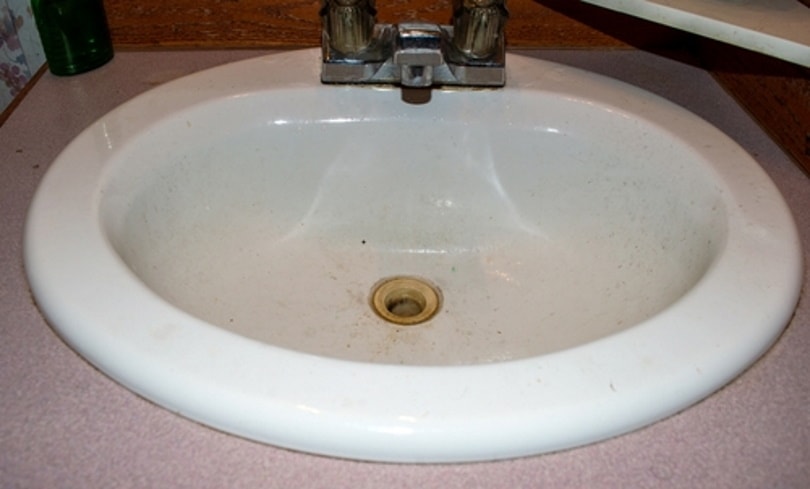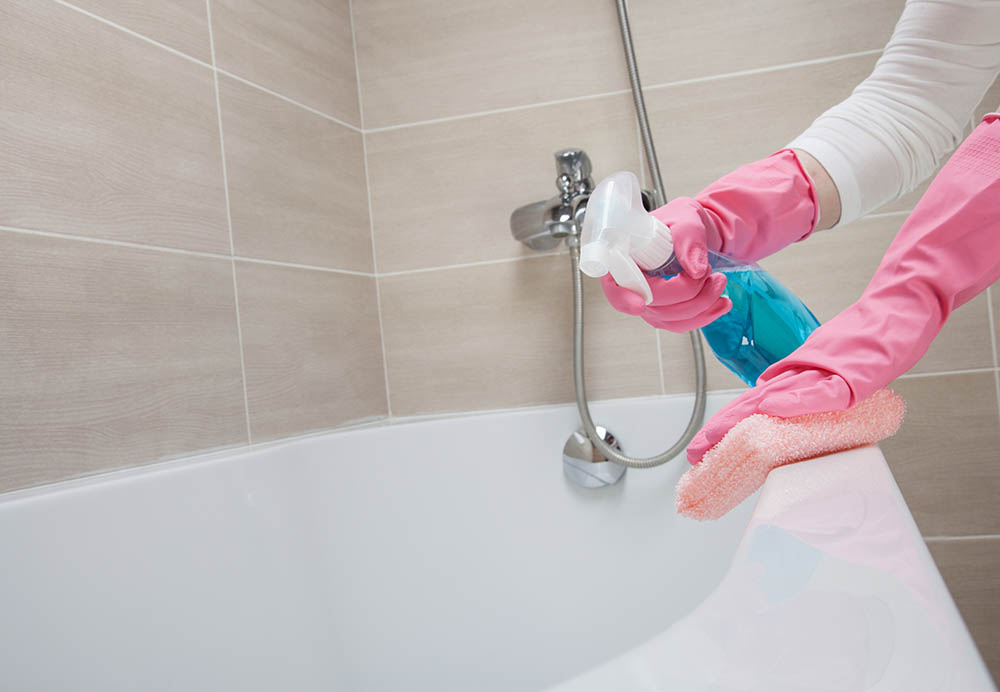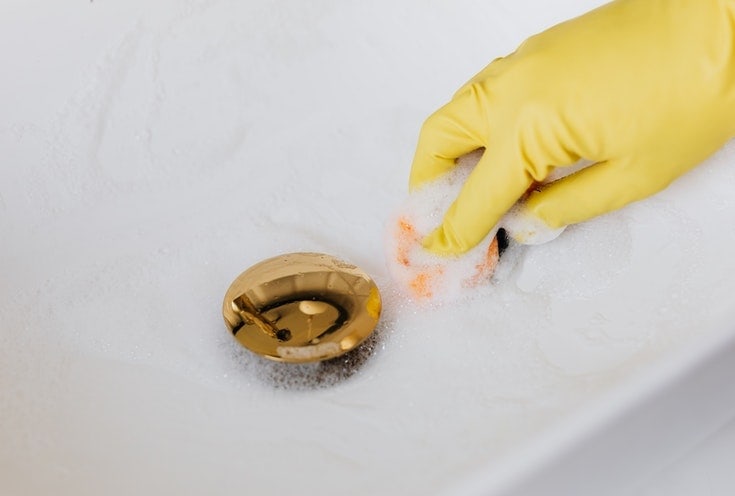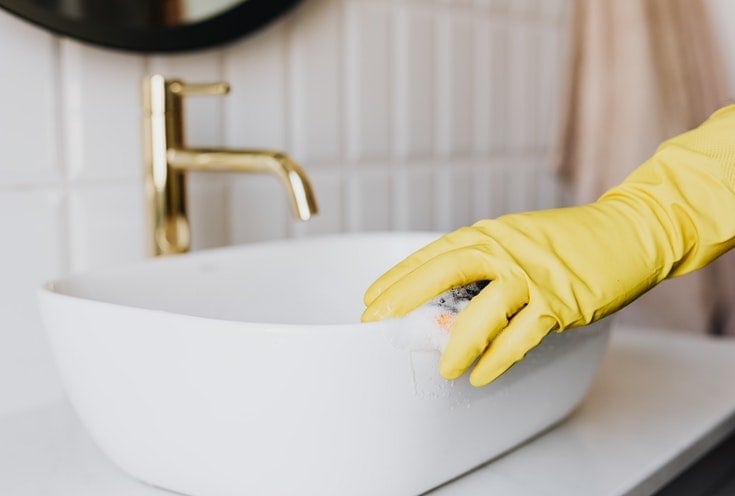What Causes Pink Mold in Bathroom Sinks? Tips, Facts, & FAQ
-
- Last updated:

Most of us have dealt with brown, black, and greenish mold in the bathroom and know how to handle it. But what about pink mold in the sink? How dangerous is it? What causes it? And most importantly, how can you remove it? Well, the good news is—unless the mold has taken over the entire bathroom, you won’t have to hire a contractor to fix it. Pink mold is actually bacteria (Serratia marcescens), not fungi.
Folk remedies like soda, bleach, and some good old scrubbing have proven to be quite effective against pink mold. And the sooner you deal with this problem, the less effort, time, and money that will take. So, get everything ready, make sure you have at least a couple of hours of spare time, and let’s get to it!

| Time Needed | 2–3 hours (on average) |
| Estimated Cost | $30–50 for the tools/materials |
| Difficulty | Beginner level |
What You’ll Need for the Job

Protection for your eyes, face, and, of course, hands is mandatory. So, put on a pair of protective gloves, goggles, and an N95 mask before you begin. To remove the mold, you can use soda, vinegar, or bleach. If you’re ready to spend a bit more, buy a bottle of disinfectant. Towels and scrub brushes will also come in handy. Here’s the full list:
- Protective gloves + eye goggles
- Face mask (N95)
- Spray bottle
- Scrub and soft-bristle brushes
- Cooling fan (optional)
- Towels, cloths, and rags
- Regular bleach
- Baking soda + dishwasher fluid
- White vinegar (5–8%)
- Disinfectant formula
Why Is Mold Taking Over the Bathroom Sink?
Like any other mold, the pink mold thrives in dark, humid environments, which makes the bathroom sink a perfect place for it to spread. In contrast, a dry area that gets lots of light is mold’s #1 enemy. Please make sure to keep the bathroom nice and clean. The dirtier it is, the easier it will be for mold colonies to grow, turning from a tiny problem into a serious issue.
If you see pink mold spots here and there in the bathroom sink, that means you’re doing a poor job of cleaning it. Again, moist, shaded, and grimy spaces stimulate mildew growth. So, even if the sink is squeaky clean, take a moment to also check the tiles on the walls and the floor, tile grouts, drains, valves, and all the tiny corners.
Technically, Pink Mold Is Bacteria
We’re used to calling everything that’s growing in water-rich, dark spaces mold, and for the most part, that’s the correct definition. However, pink mold is actually bacteria (Serratia marcescens), not fungi. Water-born, it is quite resilient and can survive in harsh conditions. It is mostly pink and has a slimy, blobby, and fuzzy appearance.
1. Start By Investigating the “Crime Scene”
Pink mold looks a bit gross, especially when it’s fully grown. But that’s a good thing because the bright color makes it easier to spot. Now, it’s not always pink, of course; sometimes, it’s orange or red. In other cases, it can be white/faded and harder to see. This greatly depends on the temperature in the bathroom. In any case, look for slimy build-up.
Even if the blobs aren’t very big, removing them right there and then should be a top priority. But before that, don’t forget to put on your “protection gear” (gloves, goggles, and a mask). Also, see that every single door and window is opened while you’re taking care of the mold. Once you’re done cleaning the sink, keep the area ventilated for at least 3–4 hours.

2. Baking Soda Against Pink Mold
In many ways, baking soda is a universal product. It’s incredibly cheap, and you can get it at any local store. And it’s quite effective not only against pet urine, oils, and other spills but against bacteria as well. If you apply it to the bathroom sink, this chemical compound will slow down its growth and make the bacteria weaker. To get the best result, mix soda with water and a little bit of dishwashing solution.
The formula for that is 2 cups of water, one tablespoon of soda, and one tablespoon of dishwasher fluid. Apply a generous amount of the “magic formula” to the sink, the drains, and the shower. Give soda 10–15 minutes to sit. Now use a scrub brush to kill the mold for good. To finish the job, rinse the area with lukewarm water. If the mold is stubborn and does not go away easily, repeat the process.

3. What About White Vinegar?
Much like soda, vinegar is an inexpensive, widely available condiment that happens to have a disintegrating effect. Mixed with water 50/50, white vinegar should be able to remove pink mold in the sink. And if it’s not, don’t dilute it at all. A quick note: white distilled vinegar is 5–8% acidic, and that allows it to put a stop to mold growth, which is exactly what we’re looking for.
Go ahead and apply the vinegar to the mold; a spray bottle will make the process easier. Give the solution 50–60 minutes to do its thing and only then scrub the area. Rinse the sink with warm water and check the results. Is the mold still there? Don’t worry; adding another layer of vinegar should do the trick. As for the distinctive smell, it will go away in an hour or two.

4. Maybe You Should Use Bleach Instead?
If you see an entire colony of pink mold, you might want to use bleach—an aggressive yet effective cleaning agent. It is strong against a wide range of mold (including black and white) and bacteria. We recommend mixing it with water (the ratio should be 1 cup/8 oz to a gallon of water). Put the solution in a spray bottle and treat all the spots that have been affected by the mold. Instead of rinsing the bleach, wipe it with dry rags.
Avoid applying this solution on dark grout (like brown or black) because it will “eat away” the color and leave the grout white. Wood, granite, marble, and unglazed tiles will suffer from bleach as well. Now, while bleach is, indeed, quite strong, it doesn’t go deep enough into the mold to kill it for good. Sometimes, bleach can even force mold to grow faster. So, to be 100% sure the threat is gone, mix bleach with soda or vinegar.

5. Disinfectant Solutions: Are They Effective?
Yes, most products that claim to kill mold/bacteria are, indeed, worth the price. So, once you’re done fighting the mold with stuff from your kitchen or the basement, go over the same areas with a disinfectant solution. Again, mix the formula with water and spray a healthy amount. Give it 10–15 minutes to sit. The chances are that will be enough to get rid of the pink in your bathroom.
And if not, apply the disinfectant again, but this time with no water mixed, to make the pink gunk decompose and decay. Grab a scrub brush and clean the surfaces by hand. Then just rinse the sink (and all the other parts of the bathroom that you just treated) to wash all the soda, bleach, and disinfectant away. See any water drops? Dry towels will help you with that.

6. Warning: Don’t Mix Chlorine Bleach with Disinfectants!
We just talked about using bleach to handle mold and mixing it with soda and vinegar. However, if it’s chlorine bleach, that can turn into a bigger problem. It’s much stronger than regular bleach, and, according to the EPA, shouldn’t be mixed with other cleaning solutions because that could produce toxic fumes. We’re talking about detergents and disinfectants that are rich in ammonia.

7. Should You Use Fans for Circulation?
The CDC recommends using fans to remove moisture that’s hard to get rid of using towels and rags. Alternatively, you can install a dehumidifier in the bathroom. It will be more efficient at keeping the humidity levels low. Plus, as mentioned earlier, make a habit of constantly ventilating the area, as that will also prevent the mold from thriving.

8. Painting Over Mold: A Good Idea or Not?
The short answer is no, there’s little reason in painting or caulking over mold/bacteria, as that won’t solve the issue. Mold is quite resilient, and it will push through the thickest layers of paint. Only do that after you’ve cleaned every trace of the bacteria. Oh, and make sure there isn’t any moisture left in the sink, as that will not only make it harder for the paint or caulk to “stick”, but also help the mold regrow.


Is Pink Mold Really Dangerous?
For the average person, no, pink mold isn’t hazardous. However, if you’re sensitive to airborne bacteria, the side effects can be severe. Asthmatic individuals with weak immune systems and people with open, exposed wounds have the worst symptoms. If you fall into one of these categories, please, treat pink mold as a very big threat.
Bacterial infections shouldn’t ever be taken lightly. They enter our bodies through wounds and open pores. That can result in bladder infections, UTI (Urinary Tract Infections), and respiratory diseases like pneumonia or asthma, not to mention bone infections, endocarditis, and meningitis.
Do you have any children, elderly people, or pets living in the house? Then be extra careful because kids, seniors, cats, and dogs have weak immune systems that can’t keep bacteria at bay. Toddlers and pets aren’t exactly great at communicating. So, it will be up to you to recognize the signs and take them to a doctor/vet.
Preventing Pink Mold Regrowth
Alright, so, you’ve successfully eradicated pink mold not only from the sink but the entire bathroom. How do you make sure it doesn’t come back? As always, proper maintenance makes wonders happen, and by that we mean you should regularly clean the bathroom. As long as the area is dry, ventilated, and not dirty, bacteria will have a very hard time growing there and posing a threat to your health.
And what about all the towels, clothes, curtains, and liners in the bathroom? Should you treat them with any cleaning solutions as well? Not quite: just wash them frequently (at least once in 2–4 weeks) and that’s it! Otherwise, these fabrics will become home to the pink mold, and you’ll have to deal with another infestation.

Hygiene and Consistency
This might sound a bit shocking (and disgusting), but the pink mold bacteria use human waste like urine and feces to “stick” to surfaces. This is another reason why pink mold is so common in bathrooms. Next, hair follicles, skin cells, and even dying plants are all “food” for pink mold. The same is true for soaps and shampoos. So, again, the better you are at scrubbing, the more efficient you will be at fighting bacteria off.
Wash your hands every time you use the bathroom, keep the area dry, and close the shower curtains when you take a shower. And don’t forget to wipe away soap scum and shampoo spills. If you don’t the bacteria will feed on it and grow back in the blink of an eye. On the bright side, if you follow our recommendations, there will be no need in paying a contractor/cleaning company to handle the bacteria.

Conclusion
Mold is a very common problem in modern-day households. It grows in dark, humid spots and slowly, but steadily spreads across the bathroom and the entire house. For most people, pink mold isn’t at all dangerous. However, if you’re sensitive to bacteria, the side effects can be quite strong. And even if it’s 100% harmful to you, it’s still very important to remove any traces before it spreads.
Today, we learned how this bacterium finds its way into our bathrooms (and especially sinks) and how to effectively get rid of it using cheap, yet effective solutions. When it comes to mold, a little bit of regular maintenance can go a long way. So, make sure to keep the sink clean!
- EPA – A Brief Guide to Mold, Moisture and Your Home
- Mold 101: Effects on Human Health
- CDC – Etymologia: Serratia marcescens
- What Are Airborne Diseases?
- Pink Mold: Is it Dangerous? And How to Get Rid of It.
- What Causes Pink Mold In Bathroom Sink Drains?
- How To Get Rid Of Pink Mold In Bathroom
- NIOSH-approved N95 Particulate Filtering Facepiece Respirators
- EPA – Should I use bleach to clean up mold?
- Molecule of the Week Archive – Ammonia
- Mold Myths: Use Vinegar or Bleach to Remove Mold?
- Pink Mold: What It Is and How to Get Rid of It
- Mold Clean-Up After Disasters: When to Use Bleach
- Reliable and Scientific Tips for Cleaning With Vinegar
- Vinegar – Wikipedia
Featured Image Credit: Diane079F, Shutterstock
Contents

